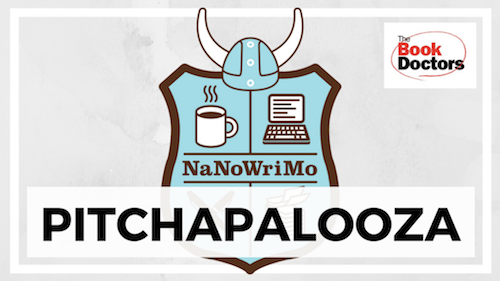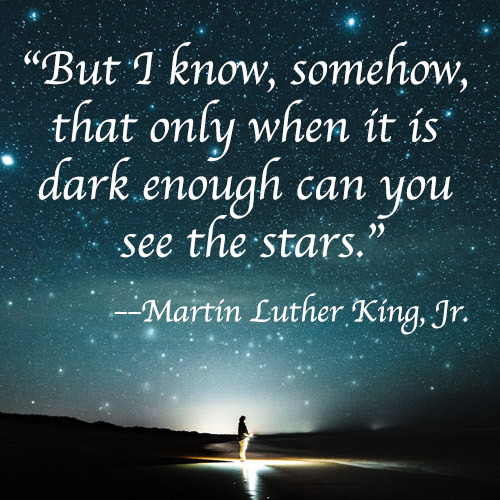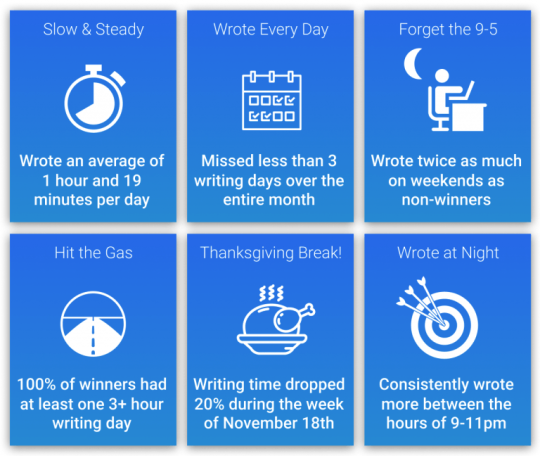Chris Baty's Blog, page 85
February 4, 2019
Love to Write? Visit Your Local Library!

Our Come Write In program has partnered with bookstores and libraries around the world for years to help create local novel-writing havens. Today, NaNoWriMo writer Jennifer Sheffield shares a few reasons why you should check out your local library:
Books are open on hardwood desks with hunched shoulders of people scribbling notes and intently taking in every word. Librarians shush and politely give warning glares to patrons carrying on too loudly. The natural light is beaming through large windows. Children and adults are hiding between shelves searching for the perfect book or research material. And sitting somewhere at a table is a group or solo writer hoping to score the next 50,000 words of a novel.
They all know something valuable about productivity: It’s all about the atmosphere.
To book lovers and aspiring authors, it should be obvious how important libraries are to a community. Unfortunately, not all communities appreciate them. If you haven’t taken the time to step inside your neighborhood library, perhaps you’re overdue for a visit.
Libraries are full of needed inspiration, whether you’re working on fiction, nonfiction, or academic writing. And beyond the materials a library can offer, they also offer patrons a sanctuary.
You might have a new set of writing goals in 2019, whether you’re planning on participating in one of the Camp NaNoWriMo events or National Novel Writing Month in November. Getting a head start on your writing is the best way to continue the habits you built from November and keep them going through the new year (especially if you’re like me and took a long break in December).
Besides setting the right ambiance at home or heading to a café to write, sometimes we find the distractions of familiarity or bustle of other people can be too much when we’re already fighting procrastination. When that happens, it’s time to revisit your list of hot spots in town and consider trying something new! Let’s start with the library.
Libraries demand respect of all their patrons—from volume to cleanliness. This means if you need a little peace or a break from how loud the world can be, the library shuts it all out! Between the stacks and comforting walls of a library you can let your mind wander as your eyes scan the shelves and focus on the soft ASMR of light keyboard tapping and pages flipping. It’s the perfect remedy.
Beyond environment, libraries are full of tools for physical and digital research. Feeling not-so-confident about how to write your next scene? Your novel’s genre has shelves full of authors who have felt the same as you. Check out how they handled their conflict and try something new in your own writing! Just imagine walking in one day and seeing your book on your local library’s shelves.
If you’re interested in getting more involved with your library, consider looking at what events they host, as well. Some libraries will hold write-ins with the community throughout November—mine does! Others are always open to working with you to get the events you and your peers want. Libraries thrive when their community takes advantage of what they offer. Don’t be afraid to ask a librarian for help.
Whether it’s the books, the sanctuary, or the events, you deserve to be part of your town’s library. And your library needs you.

Jennifer Sheffield is a full-time tech professional and freelance editor in the Seattle area. She was raised in the Atlanta area and received a BA in English from Valdosta State University with an emphasis in journalism. Jennifer is 28 years old, a Ravenclaw, and tea fanatic. Currently she’s hoping to complete the first drafts of a fiction novel and nonfiction memoir by the end of this year.
Top photo by redcharlie on Unsplash.
February 1, 2019
Pitchapalooza 2019 Now Open for Submissions!

You wrote your 50,000 words (or got pretty close!). You’re a winner. You felt the high. Now what are you going to do with your precious manuscript? That’s where we, The Book Doctors, come in.
For those of you not familiar with Pitchapalooza, here’s the skinny: You get 250 words to pitch your book. Twenty pitches will be randomly selected from all submissions. We will then critique the pitches during a live webinar on March 16, 2019 at 12PM PST, so you get to see what makes a great pitch. At the end of the webinar, we will choose one winner from the group.
The winner will receive an introduction to an agent or publisher appropriate for their manuscript.
Beginning February 1, 2019, you can email your pitch to nanowrimo@thebookdoctors.com. PLEASE DO NOT ATTACH YOUR PITCH, JUST EMBED IT IN THE EMAIL. Include your title and your name at the top of your pitch. All pitches must be received by 11:59PM PST on February 28, 2019.
We will also crown a fan favorite who will receive a free one-hour consult with us (worth $250). On March 17, 2019, the 20 random pitches will be posted on our website, www.thebookdoctors.com. Anyone can vote for a fan favorite, so get your social media engine running as soon as the pitches go up! Connecting with your future readers is a vital part of being a successfully published author today. And this is a great way to get some practice. Voting closes at 11:59PM PST on April 1, 2019. The fan favorite will be announced on April 2, 2019.
If you purchase a copy of our book, The Essential Guide To Getting Your Book Published, by April 2, 2019, we’re offering an exclusive one-hour webinar where you’ll get the chance to pitch your book. Just attach a copy of your sales receipt to your email and we’ll send the link to the webinar dates.
It’s been a great year for past NaNoWriMo Pitchapalooza winners:
Gloria Chao’s novel, American Panda (Simon Pulse/Simon & Schuster) released to multiple starred reviews. Read Gloria’s winning pitch.
Cari Noga’s novel, The Orphan Daughter (Lake Union Publishing) published in May. Read Cari’s winning pitch.
And May Cobb’s novel, Big Woods (Midnight Ink) came out in July. Read May’s winning pitch.
Are you feeling a little unsure about exactly how to craft your pitch? Here are 10 Tips for pitching your novel:A great pitch is like a poem. Every word counts.Make us fall in love with your hero. Whether you’re writing a novel or memoir, you have to make us root for your flawed but lovable hero.
Make us hate your villain. Show us someone unique and dastardly whom we can’t wait to hiss at.
Just because your kids love to hear your story at bedtime doesn’t mean you’re automatically qualified to get a publishing deal. So make sure not to include this information in your pitch.
If you have any particular expertise that relates to your novel, tell us. Establishing your credentials will help us trust you.
Your pitch is your audition to show us what a brilliant writer you are, so it has to be the very best of your writing.
Don’t make your pitch a book report. Make it sing and soar and amaze.
A pitch is like a movie trailer. You start with an incredibly exciting/funny/sexy/romantic/etc. close-up with intense specificity, then you pull back to show the big picture and tell us the themes and broad strokes that build to a climax.
Leave us with a cliffhanger. The ideal reaction to a pitch is, “Oh my God, what happens next?”
Show us what’s unique, exciting, valuable, awesome, unexpected, about your project, and why it’s comfortable, familiar and proven.
Learn more about Pitchapalooza.
Arielle Eckstut and David Henry Sterry have appeared everywhere from NPR’s Morning Edition to The New York Times to The Wall Street Journal to USA Today. They have taught everywhere from Stanford University to the Miami Book Festival to the granddaddy of American bookstores, Strand Books in New York City.
Their book, The Essential Guide to Getting Your Book Published , is the go-to book on the subject, and contains all the information you’ll ever need, taking you through the entire process of conceiving, writing, selling, marketing and promoting your book.
January 31, 2019
7 Tips for the Reluctant Editor

During the NaNoWriMo Now What? Months, we’re focused on helping you revise, edit, and publish your story. Of course, sometimes it’s difficult to make yourself do the necessary editing work on your novel draft. Today, author and Municipal Liaison Rebecca Frost shares some editing advice for the reluctant editor:
I absolutely love NaNoWriMo. I’ve been participating since 2010 and I’ll NaNoVangelize at the drop of a hat. I love the creativity, the comradery, and the craziness. My least favorite part is the editing that comes after. It’s a vital step, though, and I’ve come to terms with my process, so I’d like to share some tips in case you, too, are a Reluctant Editor.
1. Give yourself some distance.My personal rule is that I won’t start editing something until it’s been sitting for a month. If I write “The End” and then flip right back to page one, I’m too close to my book, and I’ve got the story arc still fresh in my mind so I can’t see what doesn’t actually work. I’ll save my novel in a couple different places, just in case, and then come back to it to give myself the best shot at coming to it fresh.
2. Print your novel.We read very differently on screens than we do on paper, which generally means we read them more closely. Printing something also helps my brain shift from creation mode into editing mode and forces me to let my inner editor out of wherever I’ve stashed him for November.
3. Color code your comments.I usually go in with two colors because I’ll be looking for two specific things. One of them will be for overarching comments about plot or consistency: were his eyes always blue? Did I already use “Allison” for a minor secondary character? The second will be for the mechanics: missing commas, grammar, typos, that sort of thing.
4. Read it out loud.My mouth moves when I’m editing. Many people read faster than they can talk, and forcing yourself to say—or mouth—the words slows you down so you can catch what you actually wrote on the page instead of what you think you wrote. If you have amazingly patient friends you can ask them to read it to you and listen for where they stumble, but many word processing programs also have a “Read Aloud” option. They can be a bit robotic, but also infinitely more patient than human subjects, and will let you listen to exactly what you have on the page so you can find those pesky typos.
5. Make very specific notes to yourself.There are times when I have a huge gap between my first editing read-through on paper and going back to actually input those changes digitally, and I’m often confronted with a margin note of “Huh?” or a highlighted passage with no further clue as to what Past Me was thinking. It can feel like a waste of time to carefully write out why I’m confused or how this sentence doesn’t quite fit, but Future Me really depends on those notes to make the overall changes.
6. Make yourself accountable.Editing is one of my least favorite steps of the process. I’d go so far as to call it a “necessary evil.” I like using the Page Count setting during Camp NaNoWriMo so I can see my graph grow. I also tend to post to social media during my writing process where my friends will check in and bug me if I go too many days without posting. One of the major benefits of NaNoWriMo is that we’re all going through it together during the wild writing process, so I like to lean on my friends for the editing process, too.
7. Set reasonable goals.Some days are better for editing than others. It takes a lot of a certain kind of concentration to be that focused, and sometimes my brain just isn’t up for it. I definitely can’t edit for as long as I can write, and I have to be realistic about how much progress I can make in a day.

Rebecca Frost is the author of The Ripper’s Victims in Print: The Rhetoric of Portrayals Since 1929—drafted in November 2016 as a rebel project, edited during Camp NaNoWriMo in April 2017, and published by McFarland in 2018. A Wrimo since 2010, she has been the ML for Michigan :: Upper Peninsula since 2012 and serves as her writing group’s main reference for murder and body disposal.
Top photo by Thought Catalog on Unsplash.
January 30, 2019
5 Common Mistakes First-Time Novelists Make

Every year, we’re lucky to have great sponsors for our nonprofit events. Today, our sponsor Reedsy has put together a list of the most common mistakes for rookie novelists (Want more advice from Reedsy? Check out their webcast on writing and submitting query letters!):
Writing a novel for the first time is probably one of the most daunting creative experiences in existence. Indeed, many first-time novelists have no idea how to approach it! This often means they go in blind—and end up making mistakes that seriously hinder their writing process, their novel, and their overall confidence as a writer.
And while learning from your own mistakes is a great way to cement those lessons, we can all agree that it’s not very efficient. So if you’re about to start writing a novel for the first time, here’s a quick catalog of five common mistakes that first-time novelists make, as well as how to evade them.
1. Starting without a clear purposeA staggering number of first-timers go into the novel-writing process with no greater mission other than to, well, write a novel. It’s a noble quest, to be sure—but without any other purpose in mind for your work, you’re not going to get very far.
To avoid this fate, have a prolonged brainstorm/deep thinking sesh before you begin to draft. The question you ultimately need to answer is: what kind of story am I trying to write? Not just in terms of genre and plot, but what you want the reader to take away from your novel.
This might be an outright lesson about society, as in a book like The Handmaid’s Tale. Or it might be an impression of a time/place/feeling, as in Elif Batuman’s 2017 novel The Idiot. Perhaps you want to represent a group or experience you feel is underrepresented in literature. Your novel’s purpose could be just about anything, as long as you feel strongly about it.
But whatever it is, pre-draft is the time to get ahold of it—not halfway through your novel, in a frantic attempt to conjure meaning out of thin air.
2. Being unrealistically ambitiousWhile you should definitely have goals (like purpose) as you write, you don’t want to be too ambitious—i.e. if you’ve never written a novel before, you can’t go into it thinking you’re about to write the next Gone Girl. Unfortunately, many first-timers do exactly that!
Little do they know that being overly ambitious with your first novel is a one-way ticket to Writer’s Blockville, which is walking distance from Giving-Up Town. So don’t make your writing goals too lofty, lest you become too discouraged to actually meet them.
Instead, try this: make a list of 3 realistic and concrete goals to work toward as you draft, and tell yourself to disregard everything else for the time being. A reasonable set of ambitions for a first-time novelist might be:
Write X number of words in X days (say, 50k words in 30 days, if you’re feeling up to it).Construct a relatively straightforward plot.
Focus on one aspect of your fiction writing that you know needs improvement—characterization, pacing, dialogue, etc.
Keeping solid goals like these in mind will prevent you from burning out. Just remember, the most important part of writing a first novel is just to get it down on the page. As long as you’re still writing, you’re doing something right.
3. Trying too hard to be “literary”Even seasoned writers often fall into the trap of trying too hard to sound “literary,”—like F. Scott Fitzgerald, Virginia Woolf, Zadie Smith, or any number of renowned writers. Of course, it’s great to have role models, but not if you end up sounding unnaturally ornate and formal in an attempt to emulate other novelists.
The best way combat this “over-literary” effect is to carefully monitor your prose. Be honest with yourself: if you’ve written something just to sound fancy, not because it actually contributes to the story, cut it out. When in doubt, ask someone else to test-read your work and tell you if anything comes across as pretentious or unnatural.
It’s also good to consciously stay away from other literary works during the writing process, just in case of accidental osmosis. Or if you must read (we all know it’s a hard thing to give up), try picking up novels that are nothing like yours. For example, if you’re writing a slow-burn romance, you should be able to enjoy a fast-paced thriller without worrying about the style bleeding into yours.
4. Editing right after finishingCountless successful writers and editors constantly remark on the importance of waiting to edit one’s manuscript. Yet after completing their first draft, many people dive right into the self-editing process without so much as a day’s buffer!
The result is a highly subjective—and therefore largely ineffective—editing process. You’re stubbornly attached to certain passages and subplots, and you’re so exhausted from writing the first draft that you resist the idea of revising. Basically, editing too soon after finishing your novel means you can’t get much of anything done.
Luckily, there’s an easy way around this problem: waiting a few days, weeks, or even months before returning to your first draft. While you may be eager to start sending your novel out to agents or other readers, trust us that waiting is the best thing you can do at this juncture.
This doesn’t mean, of course, that you can’t do anything else productive during the interim. You might research professional editors, or even start working on another project if you have the energy! The important thing is to clear your mind of that first novel, so that when you do finally go back to it, you’ll have fresh eyes with which to conduct a much better, deeper self-edit.
5. Never writing anything elseOne of the worst mistakes writers make is letting their first novel also be their last. Yes, some people write novels just to see if they can, or to get a story out of their system, and they’re satisfied to leave it at that. But many more people just don’t think it’s worth the effort—especially if their first novel didn’t turn out as amazing as they thought it would (see tip #2).
Allow us to dissuade you of that notion. No one’s denying that writing a novel is hard work—but the work is worth it, as long as you don’t give up. The more you practice and the more novels you write, the better your craft will become. To paraphrase Ira Glass, your skill will eventually catch up with your taste; you just have to push a bit to get there.
So don’t stop writing after your first book, otherwise you’ll never know what you’re truly capable of creating. Learn from your own mistakes, as well as the ones we’ve outlined here, and keep moving forward—to your second, third, fourth novels and beyond.
Ricardo Fayet is a co-founder of Reedsy, an online marketplace connecting authors with industry’s best editors, designers and book marketers.
January 28, 2019
5 Ways to Improve Your Action Sequences

During the NaNoWriMo Now What? Months, we’re focused on helping you revise, edit, and publish your story. Today, NaNoWriMo writer Bethany Nolan shares some editing advice on improving action scenes in your novel:
Here’s my thought process: if you’re good at editing, what does it matter how your first drafts look?
With NaNoWriMo behind us, many of you might be picking your novel back up, dusting it off, and giving it its first real read. And some of you might be finding that those pesky action scenes just don’t play out how you imagined them. Here are five things to keep in mind when you’re trying to make your action scenes come to life on the page the way they did in your head:
1. Short sentences are key.Action relies on pacing, so things need to happen. Your characters are dodging and ducking, they’re throwing punches, they’re running—they need to keep moving, so your text does, too.
In a fight, there isn’t time to think long thoughts; so short, to-the-point sentences will pick up the pace and keep the scene grounded in the action.
2. Action words for action sequences.Consider your verbs.
You don’t need to say that Person A took one punch and another and another, when you can say that Person A is being pummeled. Pummeled is a harder word than hit over and over.
What sounds more like how a gunshot feels to you? The bullet entered their shoulder, or the bullet slammed into their shoulder? Which gives the image of the victim falling back with the force? Which one makes you feel like you’re there, watching the bullet fly?
The harder the word, the harder the punch.
3. What’s important?I get it, your action hero has just entered a warehouse and the gunfire has been raining down for about three sentences now. Do I need to know the exact layout of the warehouse? Or do I need to know about the atmosphere; the flickering lights, the blood-splattered floor, the thumping footsteps? Or, better yet, should we know about this before the gunfire even starts up?
We want to propel the action forward, so we need to keep the information relevant. Your character has spotted the figure in the window to the office, watching the battle. We need to know about that more than we do about how many crates are lining the shelves.
What’s going to push your action forward? What’s going to raise the threat?
4. Who’s your writing hero?Who has written action before you? What did you like about it? Did they outline every hit, or did they focus on the roundhouse kick at the end? Did they acknowledge the bullet piercing the skin as it happened, or two minutes later, as an afterthought? Did they describe their fights like a prose poem, or with the least amount of words possible?
You have your action sequence in front of you, but maybe it needs an injection of influence from someone else’s hero. What makes Lee Child’s Jack Reacher fights so effective? Where did the action in The Hunger Games hit you hardest? How can you make your hero as effective as theirs?
(If you need extra help with this, Francine Prose’s Reading Like a Writer might be up your alley.)
5. Does it read like an action movie?It’s all well and good speeding up the pace by shortening your sentences, finding punchier verbs and cutting out filler words, propelling your action forward and writing a fight that Lee Child would be proud of—but it needs to read that way for other people, too.
So, if you’re stuck or lost, or you’ve taken it as far as you think you can go, don’t be afraid to show it to someone else and ask questions. Provide questions, even; give them things to look out for and ask follow ups for a deeper understanding of their feelings.
And don’t worry, as with all writing, rules have exceptions. Maybe your action sequence might work best with a Sherlock Holmes-esque analysis of the battleground, or maybe finding weaker words will show how poor someone is at hand-to-hand combat.
Just keep writing and editing, and you’ll find that every draft is better than the last.

Bethany Nolan is a Creative and Professional Writing bachelor’s student and a lover of ghosts, magic and space adventures. She’s also biding her time until the inevitable zombie apocalypse, when she can take on the zombie-killing role she was born to play. Her poetry chapbook about Greek mythology is called LEGENDS and her twitter, where she often rambles about said Greek mythology, is @tempestaurora.
Top photo by Thao Le Hoang on Unsplash.
January 25, 2019
Whittling Words for Stronger Stories

During the NaNoWriMo Now What? Months, we’re focused on helping you revise, edit, and publish your story. Today, writer Devyn Fussman shares some editing advice she learned from the writing courses offered by our partners at Wesleyan this past November:
What’s the only thing harder than writing 50,000 words or more? Getting rid of them. When you’re done with spellcheck, grammar check, and fixing plot holes, it’s time to cut down on wordiness. How do you do this? After auditing the Wesleyan courses offered to WriMos and trying their teachings on my own novels, I’ve figured out a few ways that work.
1. Get rid of redundancy.The first is to search for and eliminate redundant words and phrases like these (there’s another handy list in the Craft of Style course, compliments of Sophie McManus). There are tons of them, such as “plan ahead” (you can’t plan afterward) and “few in number” (few only applies to numbers).
I researched redundancies and put together a list of them that spans 13 pages. Eliminating them all took time, but once I did, I was overjoyed to see that my manuscripts were hundreds of words and a dozen pages shorter—all without losing any content. Now I make this my first step whenever I’m editing anything.
2. Read your work aloud.Next up is reading aloud, possibly to anyone who will listen. This could take a while if your work is long, but hey, no one ever said the editing process is easy or fast. An awkward sentence you might have missed when reading can become painfully obvious when speaking. After all, now you can hear it. Never is it clearer that a sentence is too long or wordy than when you run out of breath before you get to the end of it. You’re also more likely to notice repetition since now you have to pay attention to every sentence instead of scanning a paragraph. Read aloud every time you make significant edits. You’ll always find more ways to strengthen your story.
3. Sand your story.Wesleyan professor Salvatore Scibona also taught me the power of a process called sanding, which should only be attempted after enough time away from your manuscript. This is when you edit sentence by sentence. You focus on one at a time and each time, ask what you can cut. Here are some examples from one of my unfinished stories:
“The word ‘friend’ makes it sound like she was just an occasional lunch date.”
“Of course, sleep is essential to be healthy and everything, but it’s seriously a waste of time.”
I looked at each sentence as an isolated case and realized I didn’t need every word. Do I need the word ‘she?’ Yes. Do I need the word ‘was?’ Yes. Do I need the word ‘just?’ Hmm, probably not. Think of sanding like the grammar exercises you used to do in grade school. Remember when your teacher wrote incorrect sentences on the board and you had to figure out what was wrong with them and fix it? That’s what sanding is. You’re looking at each sentence as a problem to solve.
All of these take a while, but the more you do them, the faster you’ll get. The result is a better, stronger manuscript that doesn’t bury your story in unnecessary words. Less is more, and these tried-and-true tricks will help you get to less.

Devyn Fussman is a copywriter and FSU graduate. After years of participating in NaNoWriMo, she’s become a two-time winner and full-time fan. Her educational credits include a Bachelors in English with a concentration in Editing, Writing, and Media, and a certificate in Editing and Publishing. Devyn writes novels, fanfiction, poetry, articles, and everything in between. When not writing, she loves reading and video games. Find her at devynfussman.weebly.com.
Top photo by Markus Spiske on Unsplash.
January 23, 2019
Find a Safe Harbor for Critique Groups with Scribophile

Every year, we’re lucky to have great sponsors for our nonprofit events. And each year, our sponsor Scribophile likes to ask a new member who found them through NaNoWriMo to write about their experience at Scribophile. This is what author Snorri Haugen submitted:
NaNoWriMo is one of the seas upon which I sail my ship of prose. It’s an adventure with high winds, heavy waves, and all sails set. The bow crashes into the waves, throwing off cold spray, and the story pours out like the rushing sea over the edge of the world.
A couple of short months ago I made the 50,000-word journey and coached a bunch of students to writing tens of thousands of words together. It was then I started looking for a sheltered bay.
I sailed several years through the ether of the internet, making long stops at havens for writers. It was one cold Thanksgiving week when an old friend told me about NaNoWriMo. It took another year for me to jump in. And there, while cresting waves of creativity, I heard of a new harbor.
Scribophile: my new home port. Every ship needs a home port: For repair, refit, comfort … yes, and training, improvement, and practice too.
Scribophile is just that place. It’s great for any serious writer honing their skills to razor sharpness. Take that rough draft which sprang from the wellspring of your heart and mind in November, and bring that ore to the forge of Scribophile. The writers there will help you purify the ore into gold.
For years I tried to get decent assessments of my writing, without paying thousands of bucks for the privilege (OK, so I’m cheap). After the Anger and Denial phases, I skipped Negotiation and went straight to Acceptance. It seemed like I could only get one of three responses:
I Love It!*Crickets chirping* Let me give you the long long list of everything I don’t like about the content, the grammar, and you personally.Then I found Scribophile, where it’s fun to critique and be critiqued. Seriously. I get to read first drafts of great stories with wonderful original plot ideas and concepts. And I even get to put my own two cents in with the author!
Then I get to have my own writing read, reviewed, and critiqued. So instead of “It stinks” or “It’s great,” I get input which indicates someone actually read the piece before commenting.
There are a lot of established groups to hang out in and share with. The forums are full of fascinating threads on all kinds of topics including literature, publishing, and more. Genres of all types abound in this writer’s landscape, from common ones to endangered species.
Scribophile is the friendliest and most professional group I have encountered. Everyone is welcoming and supportive. I received welcomes on my profile almost immediately. The staff are top-notch, every question I have asked was answered quickly. And the web site functions flawlessly. So, if you’re a writer—get over there. The rest of us are waiting for you!

Snorri Haugen has been a firefighter, fisherman, farmer; soldier, sailor, airman, teacher, traveler, technical writer, editor for training manuals, and writer. Right now he teachers Naval Science in an NJROTC program at a public high school. He coaches marksmanship, drill, archery, and literacy. Snorri lives with his wife and daughter in what he likes to call “Middle America,” with a tiny dog in the house and seven random cats on the porch.
Top photo by Austin Neill on Unsplash.
January 21, 2019
“But I know, somehow, that only when it is dark enough can you...

“But I know, somehow, that only when it is dark enough can you see the stars.” ––Martin Luther King, Jr.
Background photo by Eidy Bambang-Sunaryo on Unsplash.
January 18, 2019
The Habits and Routines of NaNoWriMo Winners

Every year, we’re lucky to have great sponsors for our nonprofit events. After November 2018, our sponsor RescueTime put together some stats from NaNoWriMo writers who used their platform during the month. Here are a few of the interesting facts that RescueTime unearthed about the NaNoWriMo writers they surveyed:
What makes NaNoWriMo so special is that no matter what level of writer you are—amateur or professional—everyone has the same 30 days to write a staggering 50,000-word novel.
And while the time constraint makes NaNoWriMo a massive undertaking, it’s also an opportunity to see how those who hit their goal effectively spend that time.
With 58% of RescueTime users reporting that they hit their NaNoWriMo goal in 2018, we dug into how they spent their time, built routines, and stayed motivated through the entire month.
1. Winners wrote more during the first days.One of the key pieces of writing advice you hear from NaNoWriMo veterans is to hit the ground running. The first few days are an important chance to get ahead on your daily word count and set the tone for the rest of the month.
Every NaNoWriMo winner we looked at wrote consistently for the first four days and hit an average of 1 hour and 30 minutes per day. On the other hand, only 74% of non-winners wrote during the first four days of the month and for an average time of 1 hour and 12 minutes.
That might not sound like much of a difference. However, when you add that 20 minutes extra a day up across the entire month, winners had an average of 10 extra hours spent on writing during NaNoWriMo.
While everyone we looked at missed at least one day of writing during the month, winners missed significantly less.
Our data showed that NaNoWriMo winners only missed an average of 2.7 days of writing over the entire month. Non-winners, on the other hand, missed 4 or more days.
Again, it wasn’t just raw missed days that counted. Winners seemed more likely to bounce back after missing a day of writing. In fact, only 30% of winners missed two or more days or writing in a row compared to 73% of non-winners.
3. Every single winner had at least one 3-hour+ writing day.Not only were NaNoWriMo winners more likely to hit the ground running, more consistent in their writing habit, and better at bouncing back after missing a day of writing, but they also were more likely to put in long hours during writing sessions.
Without fail, every NaNoWriMo winner had at least one day where they wrote for 3 or more hours (while only 80% of non-winners had at least one 3-hour day).
Of course, these weren’t the only factors involved in determining who reached the NaNoWriMo finish line. Job obligations, health issues, and taking on too much at once can all get in the way of your writing routine. But looking at traits that NaNoWriMo winners share can help you achieve your writing goals!
Read the full post on the RescueTime blog.
Jory MacKay is a writer, content marketer, and editor of the RescueTime blog.
January 16, 2019
Making NaNoWriMo a Family Affair

If you have kids, you may be struggling with balancing your creative life with your responsibilities as a parent. Today, writer and mom Dr. Jennifer Harder shares how she’s managed to make creative writing time into a family activity:
A Holy Grail for many parents is that elusive activity you can do with your kids that you all equally enjoy. All too often, we settle for fun the kids can do while we adults look on, applaud, or otherwise support from the sidelines. We find activities that challenge our miniature selves but leave us adults stagnant. At the heart of childhood memories are shared experiences, and sometimes we adults get in a bad habit of not really sharing in the experience at all!
I learned of NaNoWriMo and its Young Writers Program in November 2017 when my son’s elementary school principal proposed it as a challenge to keep our then-second grader from getting himself into some boredom-based mischief. The idea came a bit out of the blue for me: You want my 7-year-old to write a what? In how long? I remember all of the ways that he and I struggled to subdue his inner editor, to unleash his creativity, and to learn to value the process of creating something that was utterly and completely his, all the while suppressing my urge to mom it up. It was hard.
But then, seemingly out of nowhere, it was fun.
For one month, it became our daily time together. Not only did he finish his novel, he added extra chapters because he had “more story to tell”. NaNoWriMo stuck with both of us. In 2018, September rolled around and he asked if we were doing NaNoWriMo again. We. Writing had become an us thing. Less than a year from learning what NaNoWriMo even was, we started a NaNoWriMo writing club at his new school. I thought my hands were just about full enough when my son upped the ante.
“Are you going to write one too, Mom? If I can do it, you can do it.” No more cheering from the sidelines, Mom, time to get in the game.
So on November 1st, we sat at our side-by-side computers, inner editors shoved into hidden boxes and word count goals blazoned on charts. We had just gotten underway when my 5-year-old daughter declared that she too had a story she wanted to tell. So, together, we wrote. We didn’t write alone, and we didn’t have to carve out time away from each other. We wrote as a family.
If you have a story inside of you and think you can’t possibly take time away from your family to get it down on paper, make writing a family affair. Together, you’ll be amazed what you can create! Here are some tricks to help make NaNoWriMo your new family tradition:
1. Make the Process Fun.Cheer for each other when you hit a daily goal! Talk wild plot breaks at the dinner table, go run around the yard and brain storm word sprints, or get out your colored pencils and draw silly story twists. See the work as a game, and one you can all play together.
2. Set Really Hard Goals.Who knows, you may surprise yourself, or stretch yourself trying. It’s what NaNoWriMo is all about! Kids get to choose their own word count goals, so encourage yours to stretch themselves too. Adults enjoy 50,000 words no matter what so trust me, you’ll be stretched!
3. Let Your Kids See You Struggle to Achieve Something.Kids don’t always believe that things are hard for adults. Let them see that we struggle to achieve goals too, that things don’t come easily to us just because we’re older. Let them see you work hard, let them see you fall down, let them see you fail even. Then let them see you fight back and persevere. Let them cheer you on and celebrate achievements with you. It is one life lesson that is infinitely better to model than to preach.
4. Enjoy the Story.While children relish in the world of make believe, adults learn to shove it aside as impractical. Rediscover that childhood magic with your kids. Follow their lead. Free your mind for a while from the bonds of obligation, responsibility, and cursed practicality. Do something impractical together.
5. It’s All About the Snacks.No, seriously, don’t be stingy with the snacks. The family that writes together snacks together. Cheese, crackers, and pepperoni. Apples with cheddar. Trail mix. Fuel the brain and the fingers. You won’t regret it.
As November 2018 came to a close, my son finished his story first, my daughter continued to add chapters to hers, all of the writing club kids hit their word goals, and I indeed won the year. I did something I’ve never done before, and didn’t even have to stop being a mom to do it. Next stop, a family trip to Camp NaNoWriMo this summer!

Dr. Jennifer Harder is the mom to one dragon afficionado and one fierce free spirit, the wife to a hockey aspirationalist, and the giver of treats and teacher of tricks to a pair of pups and one pup-like cat. She is the author of an untold number of unsung non-fictional works of art for her employer, and, proudly, of her first 2018 NaNoWriMo piece of pure fiction.
Top photo by Juan Cruz Mountford on Unsplash.
Chris Baty's Blog
- Chris Baty's profile
- 63 followers



